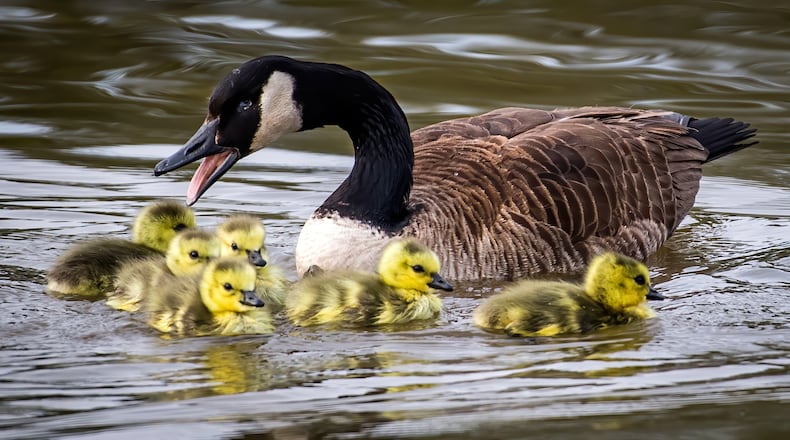Changing views
As hard as it might be for some of us to believe now, not everyone at the turn of the last century believed in science or humans’ ability to impact nature. Crazy, I know. Some thought species could never go extinct. Many species were lumped into one of two buckets: valuable or nuisance. There wasn’t any middle ground.
In that time, Giant Canada geese were extirpated from Ohio in the late 1800s. Market hunting and egg collection gave them value, but the loss of habitat through the draining of wetlands was considered a good thing if anybody cared. After that, if you saw a Canada goose in Ohio from 1900 to the 1950s it was likely just passing through on annual migration from the James Bay region of subarctic Canada to somewhere warmer. But with 10-12 distinct subspecies that vary greatly in size but subtly in markings, it can be difficult to identify them, especially on the wing.
Turning the corner
The Migratory Bird Treaty Act of 1918, sparked in response to the demise of the Passenger Pigeon, put in some protections. It brought together the U.S., Canada, Mexico and other countries to put regulations on hunting their shared wildlife resources that don’t recognize borders, as well as habitat loss.
Included in those regulations were protections for geese, goslings, nests and eggs. But there still weren’t any Giant Canada geese in Ohio.
In 1956, the Ohio Division of Wildlife began a Giant Canada goose recovery program. With 10 breeding pairs reintroduced at three different state-owned wetlands, things were off. It’s safe to say that the reestablished pairs liked the new landscape. With ripe agricultural land and essentially no predators, it was idyllic from a goose’s view. By 1979, an estimated 18,000 resident geese were living in Ohio year-round. I remember seeing my first pair before that at Brush Lake in Champaign Co. (a natural glacial lake, if you’ve heard the false rumor that Ohio has no natural lakes).
It was a wonder. We went out of our way not to disturb them. Times have certainly changed.
New classification
The population has continued to grow. According to the “Nuisance Species: Canada Geese” section of the Ohio Department of Natural Resources website, “In just a few years, a pair of geese can easily become 50 to 100 birds.” With more mowed grass spaces providing food and clear sightlines for multiple eyes to look out for predators and few predators overall, the birds got old and learned their way around. The following generations learned from them.
That’s happened over and over.
In 2012, the estimated spring population was pushing towards 150,000. Apparently, they’ve just stopped counting and decided Ohio has plenty because that’s the last record I could find. They’re not wrong. You don’t have to work very hard to see a Canada goose today.
They would be divisive if there were more people on the “support” side. Conversations are next to unanimous against them, and one where nearly everyone agrees.
They’re big and aggressively protect their nest and young. They can live almost anywhere — suburban retention ponds, parks, golf courses — almost anywhere suits them fine. They poop a lot. They’re loud.
In short, they drive people nuts and can cloud their better judgment. For example, you can’t chase them from your office or landscaping with a 9 mm handgun. Two-dimensional coyote cutouts aren’t going to dissuade them for long. However, over the same time, the migrant subspecies from James Bay has not enjoyed the same proliferation.
They still pass through, but they’re hard to tell from the resident variety. Their numbers are in decline.
Why can’t they just shoot them?
That brings us to the federally managed hunting season in Ohio. Because the regulations are established in cooperation with multiple states and countries for migratory birds per the 1918 treaty, for resident Giant Canada geese, it’s not a simple process.
In Ohio, to help address the large number of resident geese, there are multiple seasons to help control their numbers without negatively impacting others.
That’s why there’s an early season from Sept. 6-14 in 2025 with a daily bag limit of five.
There are two more seasons for Southwest Ohio later, after most of the James Bay and other migrant subspecies will have passed through. The first runs from Oct. 18-27, 2025. The second is a very generous time period running from Nov. 16, 2025-Feb. 9, 2026.
Now all you have to do is persuade them (you can’t harass or chase them with vehicles or drones) to move into shotgun range loaded with shotshells that don’t contain the traditional lead shot, in a place where it’s legal and safe to discharge a firearm.
There’s the challenge. Good luck.
Devin Meister is a local outdoors and wildlife enthusiast and has a blog called “Average Guy Outdoors.” He is an Ohio University graduate. Reach him at meister.devin@gmail.com.
RESOURCES
A not fun fact
The last Carolina parakeet, Inca, died in the Cincinnati Zoo on February 21, 1918, in the same enclosure that Martha, the last Passenger Pigeon passed away in on September 1, 1914.
johnjames.audubon.org/last-carolina-parakeet
ODNR
Ohio Hunting and Trapping Regulations 2025-2026
MORE ONLINE
Read more of Devin Meister’s columns at daytondailynews.com, springfieldnewssun.com and journal-news.com. Search “Average Guy Outdoors.”
About the Author



